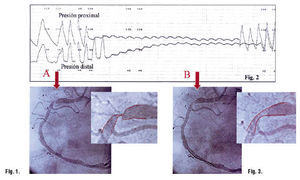Fig. 1., Fig. 2. and Fig. 3.
A pressure guide was used to evaluate the result after stent angioplasty (Unidad protocol). As soon as the guide was placed in the lesion, a significant gradient of 40 mm Hg (A) was observed that was reduced to 10 mm Hg (B) (Figure 2) within a few seconds, while the guide was being advanced toward the distal position. The angiographic image of the lesion changed at the same time, showing a lower grade of stenosis (Figure 3).
Adenosine had not been administered and the gradient did not change with the injection of contrast material. Our explanation for these findings is that the guide may have displaced or perforated the thrombotic elements of the lesion without having produced electrocardiographic changes, symptoms of angina, or changes in the distal bed.
This case illustrates hemodynamically and angiographically the role of the thrombus in the acute coronary syndrome.
Correspondencia:
Dr. J.M. de la Torre.
Unidad de Hemodinámica y Cardiología Intervencionista.
Hospital Marqués de Valdecilla.
Avda. Valdecilla, s/n. Santander.

